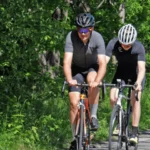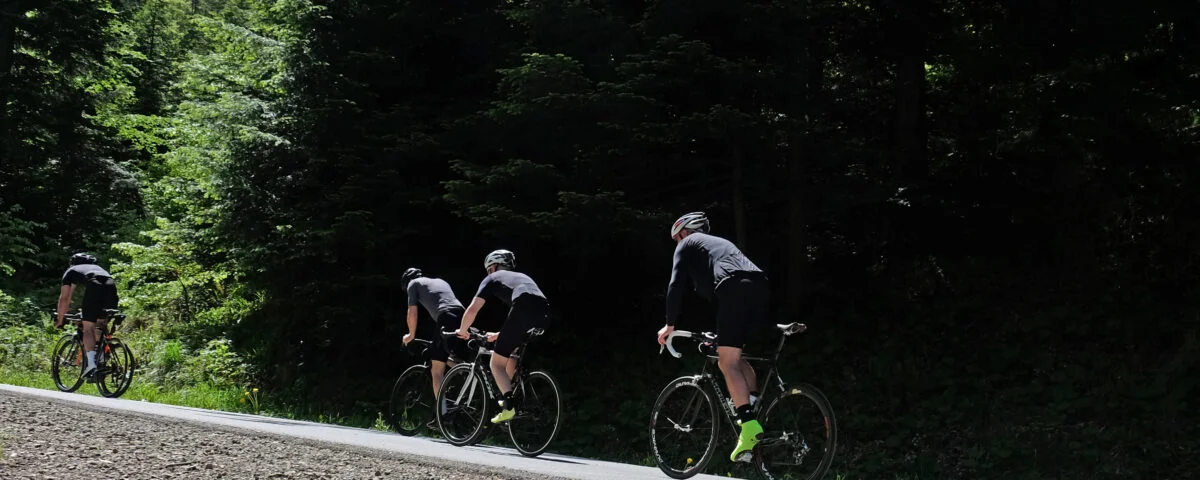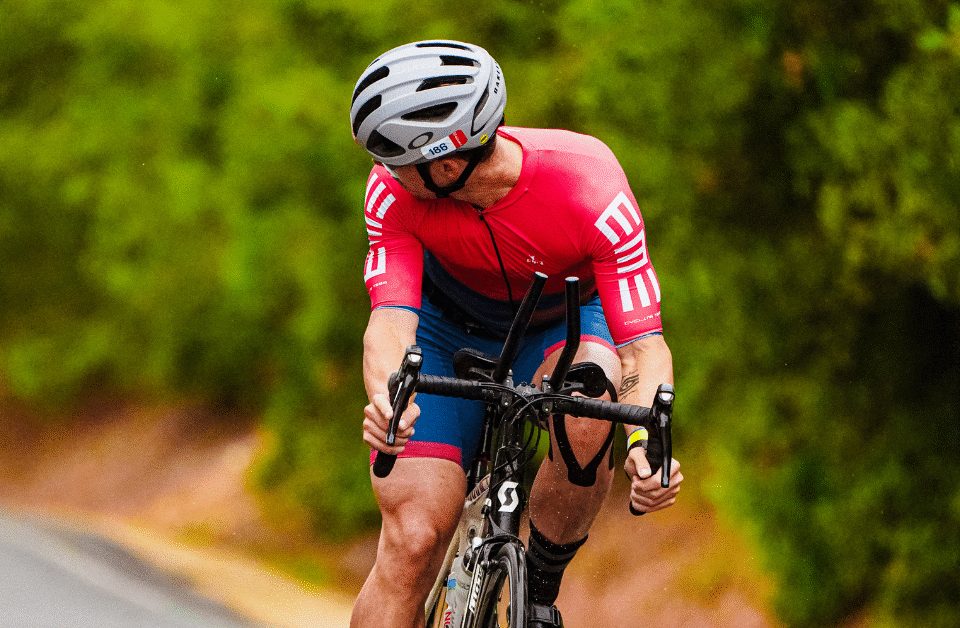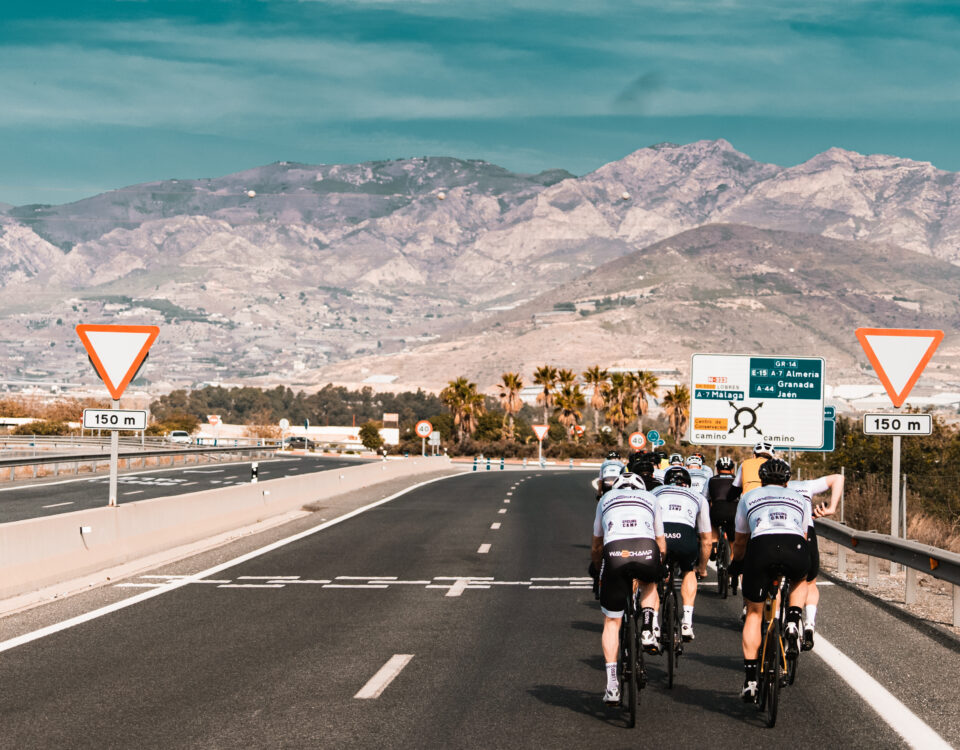
Modern cycling training based on metabolomics – a revolution in cycling
5 March 2025
INSCYD performance testing for amateur cyclists
8 May 2025
Why do the world’s best cyclists consistently incorporate short, high-intensity intervals into their training plans, even though FTP is primarily built through long, aerobic efforts? The answer is simple: anaerobic workouts are a crucial tool for improving threshold power, even if they don’t target the FTP zone directly.
FTP, or Functional Threshold Power, represents the maximum power output you can sustain for about an hour. It marks the boundary between efforts your body can metabolically manage and those that quickly lead to fatigue.
Many riders assume that improving FTP means riding near that zone for extended periods – and while that’s true to some extent, it’s far from the whole picture.
What will you find in this article?
- Anaerobic training as the missing link
- What happens in your body when you go anaerobic?
- Hormesis and pain tolerance – the secret weapon for boosting FTP
- The most effective anaerobic intervals to increase your threshold
- How to implement anaerobic training smartly – yearly strategy and periodization
- 5 practical rules for applying it in training
- Summary – how short intervals influence FTP
Anaerobic training as the missing link
Imagine Janek – a solid amateur cyclist who’s been riding at the same pace for years. His FTP hasn’t budged in ages. Meanwhile, his friend Marcin, who’s been throwing in regular high-intensity intervals above 130% FTP since day one, keeps making progress. Why? Because Janek’s body stopped receiving new stimuli. Marcin, on the other hand, keeps “raising the ceiling.”
Anaerobic efforts – short, high-intensity bursts – can range from a few seconds to several minutes. These are moments when your body is running at full throttle.
Though exhausting, they trigger powerful physiological changes:
- They activate more muscle fibers, especially the fast-twitch kind.
- They improve your tolerance to high lactate levels.
- They boost your muscles’ ability to produce energy both aerobically and anaerobically.
- They train your body to recover better between intense efforts.
Train “above” to gain “below”
Regularly exposing yourself to efforts well beyond your FTP makes riding at threshold feel easier. It’s like training sprints to improve your 5K time — once your body gets used to maximal loads, the submaximal ones feel far more manageable.
What happens inside the body when you hit anaerobic zones?
To understand why high-intensity intervals are so effective at improving your FTP, it’s worth looking behind the scenes—at what’s happening on a cellular level. Because that’s where the real magic takes place.
Our muscles rely on three energy systems:
- Phosphocreatine system – kicks in instantly, but only lasts a few seconds.
- Glycolytic system – provides energy for efforts lasting several seconds to a few minutes.
- Aerobic system – the most efficient, but also the slowest to activate.
Your FTP is largely driven by the aerobic system. But here’s the twist—anaerobic training can significantly enhance your aerobic efficiency, even though, on the surface, it may not seem directly related.
A practical example: Rafał’s story
Rafał, a 44-year-old amateur cyclist from Wrocław, spent years riding in his comfort zone—long, steady rides, always at the same tempo. His FTP didn’t budge. Everything changed when he added two anaerobic workouts per week (30/30 intervals and 3-minute efforts above 115% FTP). His body responded fast and dramatically.
Here’s what started happening inside his muscles:
- More and better mitochondria – his body increased the number and efficiency of its cellular “power plants,” producing more aerobic energy.
- Denser capillary network – improved oxygen and nutrient delivery to muscles, and faster removal of by-products like lactate.
- Improved lactate buffering – Rafał could ride at high intensity for longer without “shutting down.”
- Fast-twitch fiber activation – the anaerobic work tapped into dormant reserves. Over time, these fibers became more fatigue-resistant.
- More efficient energy metabolism – enzymes responsible for energy production started working faster and more effectively.
- Stronger heart – increased stroke volume meant better oxygen delivery and overall endurance.
And here’s a bonus: a hormonal boost. Anaerobic intervals raised his testosterone and growth hormone levels, accelerating recovery and adaptation.
After just six weeks of consistent intervals, Rafał’s FTP jumped from 230 to 261 watts. More impressively, power zones that once pushed him to the limit became his new “cruise control.”
This proves a key point: even though FTP is an aerobic metric, anaerobic training is often the catalyst for real growth. The body doesn’t adapt in neat compartments—it evolves holistically. And well-structured anaerobic intervals might just be the missing piece in your training puzzle.
Hormesis and pain tolerance – the hidden weapon for improving FTP
Anaerobic workouts don’t just change your body—they also rewire your brain. One of the less obvious but incredibly important effects of high-intensity training is how it reshapes your perception of effort. This involves a phenomenon known as hormesis—a positive adaptation to controlled stress.
Hormesis means that a moderate stressor (in this case, anaerobic intervals) triggers beneficial changes. While short, high-intensity efforts can feel unpleasant at first, the body gradually learns to cope—not just physiologically, but also mentally.
A practical example: Kamil’s story
Kamil, a 39-year-old sales rep from Poznań, spent years sticking to safe, comfortable rides—2 hours at 85% FTP, week after week. The result? Consistent but stagnant progress. Everything changed when he began incorporating 4×4-minute intervals at 115–120% FTP. The first few sessions hit him hard. “The first two weeks were hell,” he recalled.
But after a month, something shifted. His discomfort threshold began to rise. The intensity that once overwhelmed him became manageable. Long rides at threshold no longer felt crushing. His mental limit had moved, unlocking the next level of performance.
What happens in the brain when you push beyond your limits?
- Reduced pain sensitivity – muscle receptors become less reactive to fatigue-related byproducts like lactic acid.
- Prefrontal cortex adaptation – the brain learns to manage discomfort and effort more rationally, rather than automatically shutting you down when things get tough.
- Shift in perceived effort scale – what used to feel like an 8/10 might now feel like a 6/10.
- Mental resilience building – every effort beyond your comfort zone lays another brick in the foundation of confidence and self-control.
After three months, Kamil’s FTP climbed from 244 to 278 watts. But more importantly, he developed the capacity to ride hard without the mental block. As he put it, “The climbs that used to break me are now just long—they’re not painful.”
This is the clearest proof that anaerobic training isn’t just physical. It changes your mindset and recalibrates how you respond to challenge and pain. And in cycling, that often makes all the difference—not just what your power meter says, but what your mind is willing to endure.
The most effective anaerobic intervals to boost your FTP
Theory is great—but what about the practice? Which workouts actually work? Below are four proven anaerobic interval protocols that deliver serious results when it comes to increasing FTP. Each one targets a different aspect of performance—from lactate tolerance to full muscle fiber recruitment.
1. 30/30 intervals – rapid development of buffering capacity and anaerobic endurance
Structure: 30 seconds at 130–150% FTP / 30 seconds of active recovery
Set: 10–20 reps, 1–3 sets with 5 minutes rest between sets
Total work time: 10–30 minutes
Darek from Gdańsk started with 1 set of 10 reps. After 6 weeks, his FTP rose from 215 to 239 W. These intervals force the body to constantly switch between energy systems, and the short rests create intense metabolic stress.
Pro tip: Start with 130% FTP and a low number of reps. Gradually increase both intensity and volume over time.
2. 2–3 minute intervals – improving threshold power
Structure: 2–3 minutes at 110–120% FTP / 2–3 minutes rest
Set: 4–8 reps
Total work time: 8–24 minutes
Sylwia from Wrocław used these twice a week and increased her FTP from 190 to 211 W in just 8 weeks. This workout sits on the border between aerobic and anaerobic systems—ideal for extending time spent at high power.
Pro tip: Don’t start too hard. The first 30 seconds should feel “easy,” the second minute should start to hurt.
3. Over-Under intervals – race-specific endurance
Structure:
- 2 minutes “under” (90–95% FTP)
- 1 minute “over” (105–115% FTP)
Sequence: 3–5 reps without rest → 5–7 min rest → repeat for 2–3 sets
Janek from Gdańsk bumped his FTP from 273 to 307 W in 10 weeks. These intervals train your body to deal with accumulating fatigue without needing to back off—just like in a race.
Pro tip: Focus on smooth transitions between “under” and “over” efforts. Maintain cadence at 90–100 RPM.
4. Ramp-plateau intervals – maximum muscle recruitment
Structure:
- 30 seconds ramping power (from 80 to 130% FTP)
- 2–3 minutes holding 105–110% FTP
- 2–3 minutes rest
- 4–6 reps
Grzesiek from Gliwice improved his FTP from 255 to 290 W over 12 weeks. This is an advanced workout that requires both physical strength and mental focus. It activates a large number of motor units and drives deep adaptations.
Pro tip: No more than once a week—this type of workout hits the nervous system hard.
What else should you keep in mind?
- Warm-up: 15–20 minutes + 2–3 short sprints
- Cool-down: Minimum 10 minutes of easy spinning
- Volume: Adjust to your level—less is more if quality remains high
Each of these protocols works, as long as they’re well-planned and followed by proper recovery. You don’t need to do them all at once—pick 1–2 that suit your current training phase and use them consistently. The gains might come faster than you expect.
How to smartly integrate anaerobic training – annual strategy and periodization
Incorporating high-intensity intervals into your training plan is about more than just “going hard.” To avoid overtraining and achieve real progress, they need to be strategically timed according to your season phase and fatigue levels.
Grzegorz, a 44-year-old from Katowice, trained for years without structure. After introducing proper periodization, his FTP jumped from 251 to 302 W over 10 months—and he finally completed his dream race without bonking. The key? Thoughtful distribution of anaerobic work.
Season structure and the role of anaerobic sessions
Preparatory and early base phase (2–3 months)
- Main goals: build aerobic base, adapt to consistent training
- Anaerobic training: max once per week, low intensity
- Example: 6–8 × 1-minute intervals at 110% FTP with long recoveries
- Why? Prepares the body for harder work ahead
Mid and late base phase (2–3 months)
- Focus: increase volume in zone 2–3 (65–90% FTP)
- Anaerobic training: 1–2 times per week, moderate intensity
- Example: 30/30 intervals, 2-minute intervals at 110–115% FTP
- Why? Improves lactate tolerance and mitochondrial development
Build phase (1–2 months)
- Lower volume, higher intensity
- Anaerobic training: 2–3 times per week, high intensity
- Example: Over-under intervals, 3-minute efforts at 115–120% FTP
- Why? Maximize adaptations ahead of racing
Peak/race phase (2–6 weeks)
- Much less volume, only targeted sessions
- Anaerobic training: 1–2 times per week, race-specific dynamics
- Example: race simulations
- Why? Maintain fitness and freshness for competition
Kasia from Warsaw increased her FTP from 197 to 240 W in 8 months. Her secret? “I didn’t chase intensity blindly”—she followed a seasonal, strategic approach.
5 practical principles for implementation
- Progressive overload: Increase intensity and volume slowly—no more than 5–10% per week. Gradual progression helps your body adapt without excessive strain or injury risk.
- Recovery is non-negotiable: After a hard session, give yourself 24–48 hours of low-intensity riding or full rest. Use 3-day microcycles: anaerobic – easy – aerobic. This lets you train hard without burning out.
- Daily fatigue check: Rate your fatigue every morning on a 1–5 scale. If you hit a 4 or 5 for three days straight, take an easy spin or rest completely.
- Annual training cycles: Divide your year into blocks: 8 weeks of high-intensity work, followed by 4 weeks of lower-intensity training. This rotation prevents stagnation and keeps motivation high.
- Train your way: Not every protocol works for everyone. Some riders respond better to longer intervals—so instead of 30/30s, they thrive on 3-minute efforts. Adapt your plan to your personal strengths and needs.
Summary – how short intervals impact FTP
Although FTP is primarily associated with aerobic endurance, the path to meaningful improvement often leads through intensity and discomfort. Anaerobic training—short, high-intensity intervals above threshold—triggers adaptations that go well beyond their immediate effect.
They don’t just enhance your physiology; they also sharpen your mental resilience—raising your pain threshold and reshaping your perception of effort.
Anaerobic sessions are like seasoning in cooking—essential, but only when used wisely and at the right time. If you incorporate them thoughtfully, you won’t just raise your FTP—you’ll redefine how your body and mind handle intensity. And that combination—physiology plus mindset—is what wins races.
Thinking about cycling training? If you want to take your riding to the next level, we have a great option for you:
- Individual coaching – work one-on-one with an experienced coach who will continuously adjust your training load to your needs and support your development as a cyclist.

